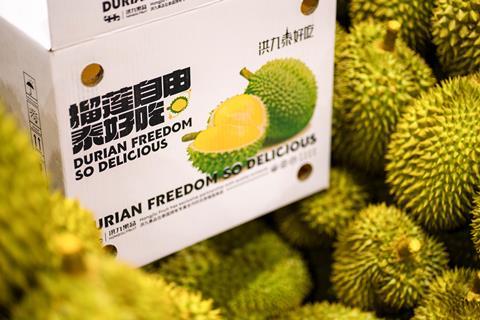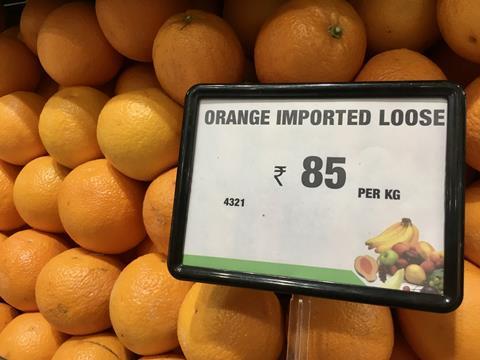Asiafruit Statistics Handbook 2024 underlines how China’s surging demand for tropical fruit is driving the intra-Asia trade

Asia’s total fresh fruit imports increased in 2023, driven by stronger intra-Asian trade in tropical fruits, particularly durian shipments to China
That is one of the headline trends in Asia’s fresh produce trade highlighted in the Asiafruit Statistics Handbook 2024.
Published by Fruitnet, the annual statistical guide to Asia’s fresh produce trade was launched at Asiafruit Knowledge Centre and Asia Fruit Logistica on 4-6 September 2024 in Hong Kong. Click here for more info.
Asian markets imported 15.6m tonnes of fresh fruit from all origins in 2023, marking a 4.1 per cent increase on the previous year, according to analysis in the Asiafruit Statistics Handbook 2024.
Intra-Asian trade led the charge, increasing by 6.2 per cent to 11m tonnes. It accounted for more than 70 per cent of Asia’s total fruit import trade. The intra-Asia trade is driven by demand for temperate fruit from the warm-climate South-East Asian markets, and for tropical fruit, including durians, bananas, and dragon fruit, from North Asian markets.
China drives Asia trade
China is Asia’s largest importer and exporter of fresh fruit, and it continues to have a major influence on the overall trade landscape. Imports edged up by 1.5 per cent to 5.9m tonnes in 2023. This included a massive 73 per cent increase in durian imports from Thailand and Vietnam.
China’s exports climbed 18 per cent year-on-year to 3.5m tonnes. Exports of mandarins increased by some 44 per cent, overtaking apples as the country’s number one fresh fruit export product. Table grape exports rose 28 per cent while apple exports declined by 3 per cent.

Mixed results for global suppliers to Asia
Global fruit imports to Asia, which are mostly made up of counter-seasonal temperate fruit, declined slightly after strong growth the previous year.
Exports from Southern Africa to Asia dipped 11 per cent to 721,632 tonnes, due to a fall in orange supply during the season.
Asia’s imports from the Middle East and North Africa grew 16 per cent, fuelled by higher volumes of Egyptian citrus and increased shipments from Turkey and Iran, particularly into India.
South American exports to Asia eased 6 per cent to 967,689 tonnes, which included almost 400,000 tonnes of Chilean cherry exports to China and other markets. Australia and New Zealand (Australasia) saw a 2 per cent decline in exports to 960,000 tonnes, mainly comprising kiwifruit, apples, citrus and grapes.
Imports from the US and Canada declined 3.5 per cent to 584,503 tonnes. Adverse weather and logistics challenges for cherries, citrus, and stonefruit were key factors in the decline, alongside strong competition within Asia from local production.
Central America increased its exports by more than 20 per cent, supplementing Asia’s supply of bananas from South-East Asia. China is spreading its supply origins for bananas across South-East Asian and Central American exporting countries.

Vietnam and India record strong growth
Key markets in South-East Asia saw imports decline, reflecting a downturn in apple and pear shipments from China. Thailand’s fruit imports dipped 5 per cent to 569,836 tonnes, and Indonesia’s dropped by 8 per cent to 611,435 tonnes, both influenced by falling apple imports. Grape imports to both markets increased, however.
Vietnam’s imports rose by 14.6 per cent to 1.4m tonnes, with mandarin imports soaring by some 42 per cent, mostly sourced from China. Vietnam’s fresh fruit exports increased 24 per cent to 1.56m tonnes. The growth was driven by a six-fold increase in durian exports to 507,000 tonnes following the opening of the China market to Vietnamese durians.
India’s fresh fruit imports increased by 23 per cent to 808,206 tonnes, led by apples from Turkey and Iran, and oranges from Egypt.
The Asiafruit Statistics Handbook presents informed analysis, helping the fresh produce industry to make sense of production, supply, and patterns of trade across 12 different Asian markets.
Access a free digital copy of Asiafruit Statistics Handbook 2024 here.
Topics
- afpromo
- Apples
- Artichokes
- Asia Fruit Logistica
- Asparagus
- Aubergines
- Avocados
- Bananas
- Berries
- Brassicas
- Cherries
- China
- Citrus
- Exotic fruit
- Exotic vegetables
- Fruit
- Grapes
- Hong Kong
- India
- Indonesia
- Japan
- Kiwifruit
- Korea, Republic
- Malaysia
- Mangoes
- Markets
- Melons
- Mushrooms
- Onions and garlic
- Pears
- Peas and beans
- Peppers
- Philippines
- Pineapples
- Potatoes
- Production & Trade
- Root vegetables
- Salad vegetables
- Singapore
- Squashes
- Stonefruit
- Sweetcorn
- Taiwan
- Thailand
- Tomatoes
- Vegetables
- Vietnam






